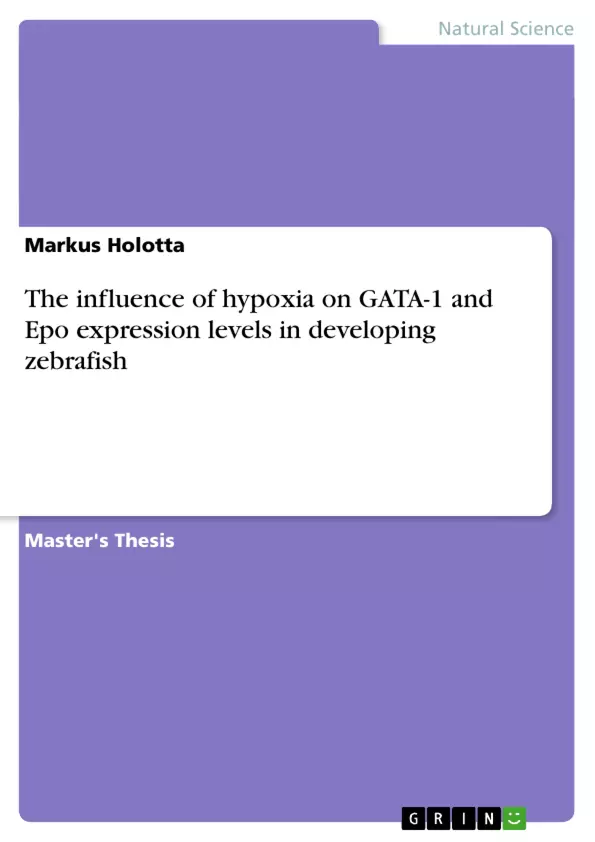The transcription factor GATA-1 is essential for the development of the erythroid cell lineage in vertebrates. In this article we introduce a method to easily determine the approximately development status of red blood cells and the progression of blood formation by intensity of fluorescence in GATA-1/Ds-Red marked zebrafish. We classified the blood cells on the basis of their fluorescence intensity in 5 intensity stages (IS) with the brightest in IS 1. The comparison with our erythropoietin (Epo) data showed a noticable correlation between GATA-1, Epo mRNA and EPO protein level. Between 2 and 3 dpf we observed a major increase in blood cell concentration to circa 1200 cells*nl-1, until 15 dpf this value decreased to about the half. The appearance of IS 1 cells correspond approximately to the peaks in Epo cRNA copies and the highest values in EPO protein emerged about 1 day later. Our data show that the blood cell concentration, Epo and Gata-1 expression in zebrafish larvae is subjected to large fluctuations in the first few days of development.
Inhaltsverzeichnis (Table of Contents)
- Abstract
- Chapter 1
- Introduction
- Zebrafish hematopoiesis
- GATA-1 and Co-factors
- The role of GATA-1
- GATA-1 related factors
- Epo and EpoR
- Oxygen dependent development
- Intention of this study
- Chapter 2
- Material and Methods
- Animals
- Imaging system
- Epo mRNA
- Statistics
- Chapter 3
- Results
- General aspects
- Total cell number
- Manually counted fluorescent cells
- GATA-1 expression
- Epo expression
- Chapter 4
- Discussion
- General aspects and observations
- Pros and cons of DsRed
- Epo and GATA-1
- In vivo imaging
Zielsetzung und Themenschwerpunkte (Objectives and Key Themes)
This master's thesis investigates the influence of hypoxia on the expression levels of GATA-1 and erythropoietin (Epo) in developing zebrafish. The study aims to understand the relationship between these genes and the development of red blood cells, as well as the role of oxygen availability in this process.
- Zebrafish hematopoiesis and its role in development
- The function of GATA-1 and its co-factors in erythroid cell development
- The role of Epo and its receptor (EpoR) in erythropoiesis
- The influence of hypoxia on the expression of GATA-1 and Epo
- In vivo imaging techniques for studying gene expression and cell development
Zusammenfassung der Kapitel (Chapter Summaries)
- Chapter 1: Introduction This chapter provides an overview of zebrafish hematopoiesis, the function of GATA-1 and Epo in red blood cell development, and the role of oxygen in this process. It also introduces the study's objectives and methodology.
- Chapter 2: Material and Methods This chapter describes the experimental procedures used in the study, including the zebrafish model, imaging system, and techniques for measuring gene expression and cell counts.
- Chapter 3: Results This chapter presents the findings of the study, including the analysis of blood cell concentration, GATA-1 expression, and Epo expression levels in developing zebrafish larvae.
- Chapter 4: Discussion This chapter interprets the results of the study and discusses their implications for understanding the role of GATA-1, Epo, and oxygen in the development of red blood cells in zebrafish.
Schlüsselwörter (Keywords)
The primary focus of this thesis is on the influence of hypoxia on the expression levels of GATA-1 and Epo in developing zebrafish. The research explores key concepts such as zebrafish hematopoiesis, erythropoiesis, transcription factors, gene expression, in vivo imaging, and the role of oxygen in developmental processes.
- Quote paper
- Mag. Markus Holotta (Author), 2007, The influence of hypoxia on GATA-1 and Epo expression levels in developing zebrafish, Munich, GRIN Verlag, https://www.grin.com/document/85354



